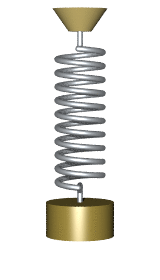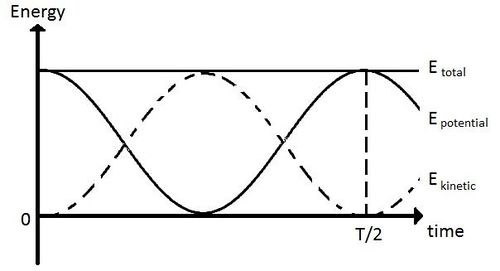Spring Potential Energy: Difference between revisions
| Line 49: | Line 49: | ||
spring.axis = box.pos - spring.pos | spring.axis = box.pos - spring.pos | ||
t = t+ deltat | t = t+ deltat | ||
[[File:spring2457.png|500 px| Oscillating Spring on Floor]] | |||
Link to Simulation: | Link to Simulation: | ||
| Line 85: | Line 87: | ||
t = t + deltat | t = t + deltat | ||
[[File:Animated-mass-spring-faster.gif| | [[File:Animated-mass-spring-faster.gif|200 px]] | ||
==Examples== | ==Examples== | ||
Revision as of 23:55, 24 November 2019
CLAIMED BY Taraji Long Fall 2019 11/15/2019 This topic covers Spring Potential Energy.
The Main Idea

Spring potential energy, also known as elastic potential energy,is the stored energy in a spring, that can potentially be converted into kinetic energy. The energy stored in the spring is due to the deformation of the spring, often from stretching and compressing. The force excreted to stretch or compress a spring is known as Hooke's law, Fs = -kxs, where Fs is force, x is the displacement, and -ks is the spring constant. The spring constant being unique for every spring depends on factors such as material and thickness of coiled wire. If a spring is not stretched or compressed, then it is at equilibrium. At equilibrium a spring has no potential energy, assuming there is no force being applied to the spring.
A Mathematical Model
The formula for Force of a Spring:
Fs = -ksx
The formula for Spring Potential Energy:
Us = 1⁄2ksx2
where:
ks = spring constant
x2 = stretch measured from the equilibrium point;
A Computational Model
An oscillating spring on the floor:
GlowScript 2.9 VPython display(width=600,height=600,center=vector(6,0,0),background=color.black) mbox=2 L0 = vector(9,0,0) ks = 1 deltat = .01 t = 0 wall=box(pos=vector(0,1,0),size=vector(0.2,3,2),color=color.cyan) floor=box(pos=vector(7.2,-0.6,0),size=vector(14,0.2,4),color=color.cyan) box=box(pos=vector(12,0,0),size=vector(1,1,1),color=color.red) pivot=vector(0,0,0) spring=helix(pos=pivot,axis=box.pos-pivot,radius=0.4,constant=1,thickness=0.1,coils=20,color=color.orange) box.p = vector(0,0,0) while (t<50): rate(100) s = wall.pos - box.pos Fspring=(L0-box.pos)*(ks) box.p= box.p +Fspring*deltat box.pos = box.pos + box.p*deltat spring.axis = box.pos - spring.pos t = t+ deltat
Link to Simulation: https://trinket.io/glowscript/3146b836dc
An hanging oscillating spring:
from __future__ import division from visual import * from visual.graph import * scene.width=600 scene.height = 760 g = 9.8 mball = .2 Lo = 0.3 ks = 12 deltat = 1e-3 t = 0 ceiling = box(pos=(0,0,0), size = (0.5, 0.01, 0.2)) ball = sphere(pos=(0,-0.3,0), radius=0.025, color=color.yellow) spring = helix(pos=ceiling.pos, color=color.green, thickness=.005, coils=10, radius=0.01) spring.axis = ball.pos - ceiling.pos vball = vector(0.02,0,0) ball.p = mball*vball scene.autoscale = 0 scene.center = vector(0,-Lo,0) while t < 10: rate(1000) L_vector = (mag(ball.pos) - Lo)* ball.pos.norm() Fspring = -ks * L_vector Fgrav = vector(0,-mball * g,0) Fnet = Fspring + Fgrav ball.p = ball.p + Fnet * deltat ball.pos = ball.pos + (ball.p/mball) * deltat spring.axis = ball.pos-ceiling.pos t = t + deltat
Examples
Be sure to show all steps in your solution and include diagrams whenever possible
Simple
Question
If a spring's spring constant is 200 N/m and it is stretched 1.5 meters from rest, what is the potential spring energy?
Solution
ks= 200 N/m
s= 1.5 m
Us=(0.5)kss2
Us= (0.5)(200 N/m)(1.5 m)2
Us= 225 J
Middling
Question
A horizontal spring with stiffness 0.6 N/m has a relaxed length of 10 cm. A mass of 25 g is attached and you stretch the spring to a length of 20 cm. The mass is released and moves with little friction. What is the speed of the mass at the moment when the spring returns to its relaxed length of 10cm?
Solution
ks= 0.6 N/m
s= 0.1 m
Us=(.5)kss2 = (.5)(0.6 N/m)(0.1 m)2
Us = 0.003 J
Potential Energy is Converted into Kinetic Energy (K):
Us = K
Us =(0.5)mv2
0.003 J = (0.5)(0.025 kg)v2
v2 = (0.003 J)⁄((0.5)(0.025 kg))
v2 = 0.24 J/kg*s
v = 0.49 m/s
Difficult
Question
A package of mass 9 kg sits on an airless asteroid with mass 8.0x1020 kg and radius 8.7x105 m. Your goal is to launch the package so that it will never come back and when it is very far away it will have a speed of 226 m/s. You have a spring whose stiffness is 2.8x105 N/m. How much must you compress the spring?
Solution
The initial condition for escape from the asteroid is:
Ki+Ui=1⁄2mvesc2 + (-G*Mm⁄R)=0
Potential energy of the spring equals the total energy in the system.
1⁄2kss2=1⁄2mvesc2 +(-G*Mm⁄R)
s2= m⁄ks(2GM⁄R +v2)=s2 = 9⁄2.8x105(2G8.0x1020⁄8.7x105+2262)
s2=5.58 m
s=2.36 m
Graphing
Energy graph
The energy graph of a oscillating spring continuously switches between kinetic and potential energy because springs are continuously returning to equilibrium.
Connectedness
Because springs are all around us, from Slinkies to parts in automobiles, spring potential energy is useful in everyday life. One example of this is a trampoline. Without potential spring energy to allow for bounce, a trampoline would simply be a boring stretch of fabric. Spring potential is also used to absorb shock in vehicles. This allows for a smoother ride while traveling over bumps in the road.

History
Elastic Potential Energy stemmed from the ideas of Robert Hooke, a 17th century British physicist who studied the relationship between forces applied to springs and elasticity. Hooke’s Law, which is a principle that states that the that the force needed to extend or compress a spring by a distance is proportional to that distance.
See also
Spring potential energy is related to Hooke's Law and Potential Energy.
Further reading
http://hyperphysics.phy-astr.gsu.edu/hbase/pespr.html
External links
References
- http://www.universetoday.com/55027/hookes-law/
- http://www.scienceclarified.com/everyday/Real-Life-Physics-Vol-2/Oscillation-Real-life-applications.html
- http://hyperphysics.phy-astr.gsu.edu/hbase/pespr.html
- Chabay and Bruce A. Sherwood. Matter & Interactions. 4th ed.


